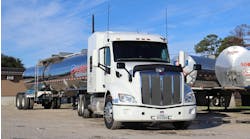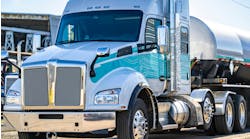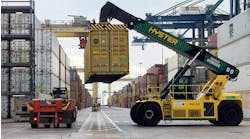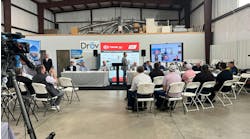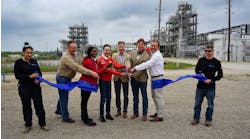Another gallon of motor fuel. The people to help sell it.
Those are the essential ingredients in Offen Petroleum’s evolving fuel-delivery operation, which this year surpassed 2 billion gallons of annual fuel distribution.
Everything else is a means to Offen’s ultimate end—a 10-billion-gallon business.
The Commerce City, Colo.-based company’s trucks and trailers simply are the logistics tools used to move marketed fuel, recent private equity involvement helps to ensure Offen’s ongoing inclusion in a rapidly consolidating fuel-distribution landscape—unlocking exponential growth through acquisitions—and those additions deliver new customers, equipment and terminals the company needs to sell another gallon of fuel.
Most importantly, Offen’s four acquisitions since 2018 brought more people, who, when treated well, will help the company advance its market presence—which is why a properly motivated workforce is the key, not-so-secret additive in its growth-oriented blend of fuel and lubricant distributors in the Rocky Mountains and beyond.
“When you build a business on the back of logistics, if you don’t have the drivers, dispatch staff, and local knowledge in the marketplace behind you, you’ve set yourself up with a difficult field to till,” Offen CEO Bill Gallagher said.
“But with those folks on board, you’ve set yourself up for success.”
‘Virtuous cycle’
Gallagher’s success with Offen, which he and his sister, Gwen, purchased in 1997, is built on a foundation of fuel delivery expertise spanning 10 decades
The company started out as Reedy Coal and Fuel Company, a coal and home heating oil delivery business, in the late 1930s. Jim and Ester Offen purchased the company in 1967 and changed its name to Offen Petroleum. They sold the business to three trucking industry partners, Jim Eichenberger, Jack Shupe and Fred Ashley, in 1977, and that trio ran Offen until 1997, when the Gallagher siblings decided they wanted in.
Their father, who also worked for Exxon, owned a small fuel distributorship until Gallagher, born in Tripoli, Libya, was in high school, so he was familiar with the idea of delivering fuel to service stations, commercial customers and ag accounts; and looking for a way to return to Colorado, where he attended the University of Colorado Boulder. When he learned from Eichenberger, an old family friend, his group was looking to sell Offen, he jumped at the chance.
“At the time, Offen Petroleum was selling about 8 million gallons of motor fuels and 1 million gallons of lubricating oils,” Gallagher recalled. “We wanted to form a strategy for growing the business, and we elected to do it on the back of logistics, always using logistics as a means to sell a gallon of fuel, and never thinking about logistics as a means, in and of itself, to generating revenue.”
They picked logistics because of its relatively low barrier to entry. “My sister and I both were young, and we didn’t have a lot of access to capital, but there was always somebody willing to finance a truck for you,” Gallagher said. “So we thought, ‘Hey, we can go buy some trucks, and find the right types of customers to sell a load of fuel to.’ Then we could pivot from being just a logistics provider, suffering through the boom-bust cycle of transportation, to being a fuel provider—which was the business we purchased—and grow using logistics as the method that allows us to open doors and execute with customers.”
The strategy worked. From 1997 to 2017, the duo grew Offen from 9 million gallons to 650 million, primarily by expanding its transportation fleet, better utilizing those assets, and improving efficiency. Their only acquisition during that period was Riggi Oil, purchased in July 2015, which was a commercial fueling facility selling less than 1 million gallons of fuel per year, so almost all of that growth was organically enabled by Offen’s logistics execution, and first-rate performance with high-volume retailers and chain operators. “It’s a virtuous cycle,” Gallagher said. “You execute for the customer, they reorder, you execute for that customer again, you begin to build scale with suppliers, and that scale yields more opportunity in the marketplace for additional volume with which to service customers.”
But after 20 years of prosperity, they needed a new approach. While Gwen was eager to exit the business, Gallagher wanted to keep it growing, which was increasingly difficult in what he says is a “dramatically shrinking” fuel-delivery industry. They both got what they wanted by turning to Denver-based PE Lariat Partners in 2017.
“Today there are over 3,000 fuel distributors in the United States, and we believe that in the next 10 to 15 years there will be under 300,” Gallagher said. “We wanted to participate further in that consolidation, and the way we felt we needed to do it was by utilizing private equity to help us finance our growth. It also allowed my sister, who had been with me since she was 22 years old, to step away and spend more time with her family, and allowed us access to capital to expand the business significantly.”
Rapid expansion
Gallagher attributes industry consolidation to a convergence of factors, including electric-vehicle penetration in the fuel marketplace, the sophistication of a mature market—with fewer refiners and marketers who need ever-larger balance sheets to continue to execute on multiple fronts within the fuel supply chain—and the escalating cost of the systems that help streamline operations and deliver value for customers.
Private equity investment provided the resources Offen needed to compete.
Offen acquired Overland Petroleum in September 2018, and Allied Energy in May 2019. One month later, Lariat sold its interest to New York-based Court Square Capital Partners, but Gallagher and his management team maintained their minority stake in Offen and, with Court Square’s support, continued to execute on Gallagher’s vision, acquiring Ozark Mountain Energy in December 2020, and Petromark in May of this year.
Aaron Hackerott, Offen’s chief operating officer, called the acquisition of Overland, with 400 million gallons of distribution, its first “transformative” pick-up.
“We went from 650 million gallons, to north of a billion gallons of distribution,” he said. “So it was a great acquisition for us. Culturally, they fit with us perfectly. They sold full-transport loads of fuel, and also believed in the idea of, ‘I have to execute on the delivery of this gallon in order to sell another gallon.’ And the sellers there, specifically one gentleman by the name of Darin Snow, had carried that strategy forward, and continues to do so for Offen today (as executive vice president of pricing and supply).”
The acquisition of Ozark, Offen’s largest to date, added another 650 million gallons of distribution to the company’s network, and the absorption of Petromark injected 100 million gallons—pushing it past 2 billion per year. Most of that is marketed gasoline and diesel, combined with smaller quantities of propane, diesel-exhaust fluid, and lube oil, and approximately 15% of the 2-billion-gallon total is hauled as a carrier only.
Each acquisition also expanded Offen’s geographic footprint. With Allied, in Phoenix, Ariz., on board, Offen moved into new Arizona and Nevada markets, which, combined with St. George, Utah-based Overland, extended its service area west. Adding Ozark in Mt. Vernon, Mo., and Petromark in Harrison, Ark., extended its range eastward.
Traditionally, the company grew in the Rocky Mountain region, or PADD IV, one of five Petroleum Administration for Defense Districts (PADDs) created during World War II. Now Offen extends into 24 states, stretching from Nevada to Tennessee, and North Dakota to Texas, with its leaders thinking about the business in three regions: the Rocky Mountain region, which includes all of Colorado, and parts of New Mexico and Wyoming; the West region, including Utah, Nevada and Idaho; and the Ozark region, encompassing Missouri, Arkansas, and parts of Oklahoma and Kansas. “That’s where our greatest density lies,” Hackerott said.
When they’re evaluating potential add-ons, Offen’s leaders examine earning streams, operator reputations, customer overlap, and geographical and cultural fit, particularly around the core values of accountability, discipline, and drive. If they move forward, and execute a transaction, Gallagher says the priority shifts to making sure every employee understands what’s next, so they stick with Offen through the transition.
“We want to answer three questions for them immediately: Do you have a job, who’s your boss going to be, and how are your benefits impacted?” he said. “Those are the things we think about from their perspective.”
Blending business
Along with an influx of employees, acquisitions bring novel equipment, systems, and processes that must be combined for optimal efficiency, which often is easier stated than accomplished. Amalgamating Petromark’s operations has been a challenge because it didn’t utilize the same Trimble transportation management and fleet maintenance software.
“That’s been challenging on both sides, for that reason alone,” said Kaleb Hoffer, director of fleet operations. “We’re learning the quantities, volumes, and run rates these stores are going through, while simultaneously drivers are learning all new dispatchers, managers, and billing procedures. So there are some challenges on the integration side, but the culture is there, so all we have to do is train each other.”
Advanced dispatch and asset tracking systems allow companies to execute from a data processing standpoint, Gallagher said, which is why the company places a high priority on Court Square-sponsored “Project Octane,” its ongoing process improvement initiative, which currently is centered on integrating Trimble’s TMW tools with its back-office software, enabling delivery of customer information to Offen’s enterprise resource planning (ERP) system.
“We’ve continued to grow organically by utilizing inventory management tools, so we’re directly tying into our customers’ tanks, and managing fuel inventories for them,” Gallagher said. “They can sleep at night knowing we’re taking care of that. And we’ve grown by providing back-office resources and supports, so dedicated resource officers or customer-service reps, who, for our largest, most critical accounts, can manage and answer questions, whether it’s around a bill of lading, an invoice, or reconciling an item at month’s end.”
Trimble’s integration with PDI Software’s TelaPoint allows Offen to pull tank inventories; and the company’s PeopleNet electronic-logging devices (ELDs) give Offen access to real-time information from TMW Fuel Dispatch—a module Hoffer greatly appreciates. “TMW is one of the few products out there that is built around tanker deliveries, and the tanker workflow feature allows our dispatch team to communicate directly with the cab, regardless of who’s driving, and dispatch loads that way; and it allows drivers to make modifications to what they actually picked up or dropped off at the customer’s location, and pull that information back into our computers seamlessly,” he said. “And then all of that information loads into our ERP system. So that is a very key feature we’re keen on keeping, and improving on.”
But complex integrations take time to implement, and often can prove disruptive to the day-to-day activities that keep fuel moving.
“We want to tread carefully because, as managers of this business, we want to act humbly, when we show up in a new region, about what we don’t know, and there’s a lot we don’t know when we acquire a new business, even though we’ve done months of due diligence and tremendous amounts of work,” Gallagher said. “There are reasons, oftentimes, a business executes and behaves the way it does, so we want to make sure if we’re changing one of those factors, it’s not adversely affecting the earning potential of that business, the customer service from that business, or impacting our employees in a negative way.
“There may be some pain getting over the hurdle, but our goal with all of these kinds of transitions is to improve the lives of the people we deliver for, and for our employees.”
Driver's-eye view
When evaluating transportation systems and equipment, Offen also considers “the view from the cab” to ascertain how theoretical improvements appear in practice from the driver’s perspective. “We want to make sure we’re improving their lives,” Hackerott said. “We’re trying to make our systems and processes better, and our operations more efficient, so how does this look from the cab of the tractor?” Hackerott said.
With the additions of Overland, Ozark, and Petromark, Offen grew its fleet to 150 power units, including tank wagons and box trucks for lube deliveries, and 189 trailers, with 187 drivers. Most of Offen’s tank trailers are multi-compartment, DOT 406 aluminum trailers, but the company also has 11 propane trailers.
Offen primarily runs Peterbilt Model 389s with Cummins engines in its Ozark region. It also utilizes Freightliner Cascadia daycabs with DD13 engines for local work, and Cascadia sleeper trucks with DD15s for over-the-road work. Both Cascadia models are equipped with DT12 automated shift, 12-speed transmissions, and air-ride suspensions.
All trucks and trailers are equipped with disc brakes. Tractors sport Alcoa aluminum wheels and low-profile, 22.5-inch tires, with most coming from Yokohama. Offen uses wide-base (super-single) tires on most new trailers. Tractors are spec’d with PTOs and 3-inch Blackmer pumps for deliveries to above-ground tanks.
“I’m pretty brand-agnostic,” Gallagher said. “It’s about uptime, driver satisfaction, and dependability. That’s what we look at when we think about a tractor and a trailer, along with, to a certain extent, resale value. But we don’t get too wrapped up in resale because we really view this as a cost of goods to deliver fuel.”
Trailers primarily come from Heil and Polar. Configurations include five-compartment, 9,500-gallon tanks with double-bulkhead construction and elliptical bottoms; two-compartment, 5,400-gallon pup trailers, and three-compartment, 6,300-gallon short-lead trailers. New trailers sport WABCO disc brakes, ConMet hub assemblies, and Hendrickson TIREMAAX PRO Tire Pressure Control Systems. Other trailer equipment includes fittings from OPW, Dixon and Civacon, Tuthill Fill-Rite additive pumps, Liquid Controls meters, and Kanaflex hoses.
“We try to keep everything standardized, in regard to our liquid trailers,” Gallagher said. “You can get about 1,000 different combinations for compartment sizes, but we want to keep that all uniform. That way if a trailer moves to a different region, it’s relatively easy for our dispatch teams to schedule that trailer out.”
Hoffer said they don’t currently install cameras in tractors, but that’s something they’re actively researching. “If we’re going to do something, we’re doing it to protect the driver, and the company,” he said. “We don’t want to come across as ‘big brother’ to the driver.”
Measure of demand
With manufacturing constraints and workforce shortages handicapping the entire transportation industry, companies can’t afford to alienate quality drivers already on staff. That’s especially true in the fuel distribution segment, where a dearth of drivers with fuel-hauling credentials has caused tank carriers to idle as much as 25% of their trucks, according to National Tank Truck Carriers president Ryan Streblow.
Hoffer, and other industry experts, point to the pandemic as a primary culprit in the fuel hauler shortage. When demand plummeted early last year during the COVID-19 crisis, many of those drivers were let go, retired, or left for other industries; and driving school closures severely impacted the flow of new drivers.
Gallager has seen supply issues lead to rolling outages in big markets like Las Vegas, Salt Lake City, and Reno, with the worst shortages heading into the summer months. “Going back to last December, we planned and built out a pretty aggressive budget around repopulating our driver force, rehiring drivers, and rebuilding and growing our pool of drivers, and we were successful with that throughout the first quarter,” he said. “Then we started to see a significant market shift around compensation for drivers, and bringing drivers into the market in the last several months, as demand really picked up.”
Offen’s worst day demand-wise last year was on Easter Sunday, Hackerott said, when gasoline demand plummeted 75% from 2019 levels. Overall demand was down roughly 60% for an extended period in Offen’s largest markets, he said. But demand steadily has climbed since then, and now is back to “pre-pandemic levels.” The U.S. Energy Information Administration agrees, saying in a recent report current U.S. gasoline demand is nearly identical to the same period of 2019—and up 16% from the end of 2020. EIA expects demand to continue increasing into 2022.
Fortunately, while Offen hasn’t onboarded as many drivers as desired, the company has grown through acquisitions, and kept its current pool mostly intact, allowing it to continue supplying customers with fuel—even as competitors falter. “As we look at the regions we’re in, where we’re able to execute day in and day out, make deliveries and keep product in tanks, some of our customers are gaining an advantage, because their competition down the street is out of product, due to the shortage of drivers in the market,” Gallagher said. “So we’re seeing a slight increase in volumes that way.”
Going forward, Offen’s CEO says they’ll continue to hone the company’s strengths, including full-truckload deliveries, over adding new logistics services or transportation modes. And he’s determined to protect its reputation as a premium provider by staying in the top of the market on driver compensation and benefits. “We’re in the business of selling fuel, so we’re going to make sure we have the drivers to do it,” he said.
They’ll also keep evaluating potential acquisitions, focusing on those that can boost market density. Because while the distributor count is dwindling, Offen leaders still see “tremendous upside” for the remaining suppliers, especially those with another gallon of fuel to offer—and the right people to help sell it.
“Liquid motor fuels will continue to be an important part of the economy, and we’re going to be a critical link in executing that for our customers and suppliers, and have a strong employee pool to do it,” Gallagher said. “We strongly believe over the next five years Offen Petroleum will be moving 10 billion gallons of motor fuels. So there’s a lot of opportunity on the horizon as we shrink from 3,000-plus fuel distributors to 300.”
